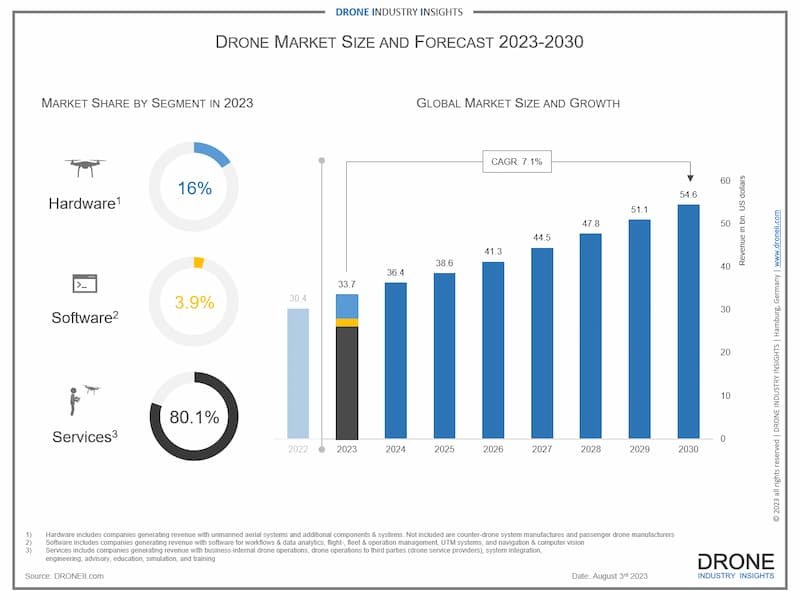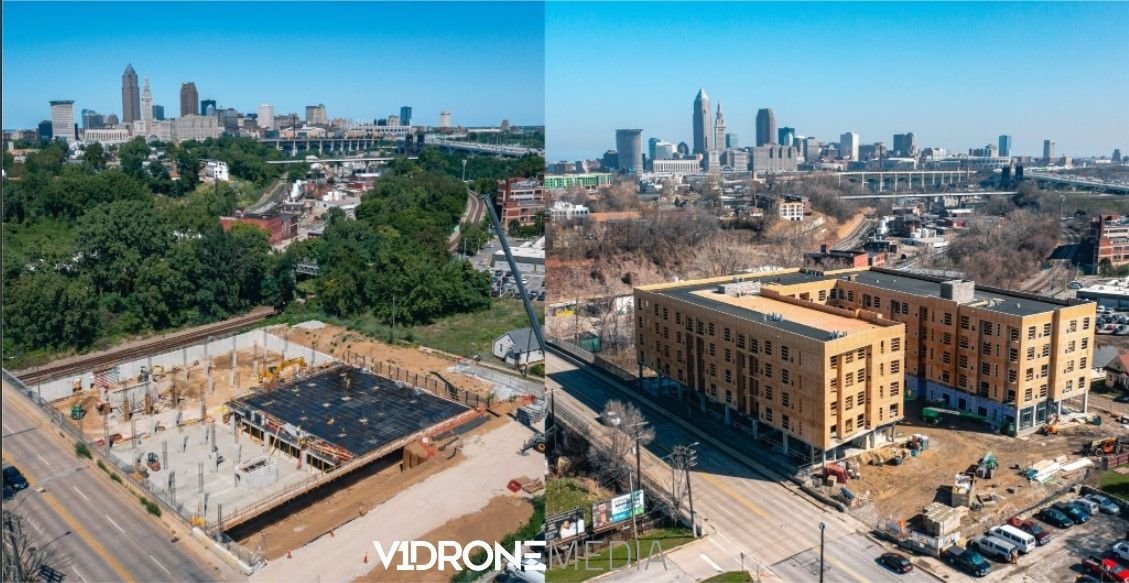The rise of drone technology has sparked a revolution in law enforcement, leading to an increased demand in drone pilots at law enforcement agencies across the United States. Police departments all over the United States, including Ohio, New York, Michigan and Pennsylvania are integrating unmanned aerial systems (UAS) into their operations. This shift has created a need for comprehensive training programs that equip officers with the skills to operate drones effectively and safely in various scenarios, including crash scene reconstruction, search and rescue missions, and evidence collection.
Police drone operator training goes beyond basic flight skills. It encompasses a wide range of competencies, from mastering standard flight maneuvers and aerial imagery to understanding specialized applications like aerial photogrammetry an even thermal imaging. This article delves into the key skills and certification requirements for police drone pilots, exploring the essential components of UAS training courses. It also examines how different states approach law enforcement drone training and the specific applications that make drones invaluable tools for modern policing.
FAA Certification Requirements for Police Drone Pilots
The Federal Aviation Administration (FAA) has established specific to ensure safe and legal operations. These requirements are crucial for law enforcement agencies integrating unmanned aerial systems (UAS) into their operations.
Part 107 Remote Pilot License
The foundation of police drone training is obtaining a Part 107 Remote Pilot License. This certification applies to drones weighing used for commercial purposes, including law enforcement activities. To obtain this license, police officers must meet several criteria:
1. Be able to read, speak, write, and understand English
2. Be in a physical and mental condition to safely operate a drone
3. Pass the initial aeronautical knowledge exam, known as the "Unmanned Aircraft General – Small (UAG)" test, also known as Part 107 Test.
The Part 107 certification allows police drone operators to fly their UAS at daylight or at twilight and nighttime hours with anti-collision lighting. However, they must always yield the right of way to manned aircraft and obtain permission to fly in controlled airspace 400 feet within their line of sight
Studying for the FAA Part 107 Exam
Preparing for the Part 107 exam is a crucial step in police drone training. The exam covers a wide range of topics, including:
1. Applicable regulations for small UAS operations
2. Airspace classification and operating requirements
3. Aviation weather sources and effects on small UAS performance
4. Small UAS loading and performance
5. Emergency procedures
6. Crew resource management
7. Radio communication procedures
8. Determining the performance of small UAS
9. Physiological effects of drugs and alcohol
10. Aeronautical decision-making and judgment
11. Airport operations
12. Maintenance and preflight inspection procedures
Many police departments allocate between 15 to 20 hours of study time for officers to prepare for the test. Various resources are available, including online test prep courses and free materials provided by the FAA. It's essential for police drone training programs to incorporate comprehensive study materials and practice tests to ensure officers are well-prepared for the exam. If you are a police officer looking to get your Part 107 drone pilot license, you can take our regularly scheduled 2-day in person Part 107 Prep class in the Cleveland, Ohio, area, and take the exam to get your Part 107 certificate shortly thereafter. If you are a police department that is looking for multiple officer Part 107 training, along with flight experience training, explore our drone training options for law enforcement, which we can bring directly to your department.
Practical Flight Experience
While the FAA does not mandate a specific number of flight hours for certification, practical flight experience is crucial for police drone operators. Law enforcement agencies often incorporate hands-on training into their UAS programs to ensure officers can effectively operate drones in various scenarios.
Key aspects of practical flight training for police drone operators include:
· Mastering basic flight controls and maneuvers
· Understanding drone capabilities and limitations
· Practicing emergency procedures
· Conducting simulated missions relevant to law enforcement, such as search and rescue or crash scene reconstruction
· Familiarizing officers with specific drone models used by their department
· Practicing a variety of flight scenarios to get more familiar with the controls
It's worth noting that an individual can obtain an FAA Remote Pilot Certificate without ever having flown a drone. However, for police drone training programs, incorporating practical flight experience is essential to develop competent and confident operators. There is a variety of ways to assess the competency of police drone pilots which can be built-in to police drone training programs.
To maintain their certification, police drone pilots must complete an online recurrent training course every 24 calendar months. This ongoing training helps ensure that officers stay up-to-date with the latest regulations and best practices in UAS operations.
By adhering to these FAA certification requirements and incorporating comprehensive training programs, law enforcement agencies can develop skilled and compliant drone operators, enhancing their capabilities in various police operations.
Essential Flight Skills for Law Enforcement UAS Operations
Law enforcement agencies integrating unmanned aerial systems (UAS) into their operations require officers to develop a specific set of skills to operate drones effectively and safely. These skills are crucial for various applications, including traffic collision reconstruction, and aerial surveillance, and search and rescue missions.
Basic Maneuvers and Controls
Mastering is fundamental for police drone operators. This includes the ability to perform precise takeoffs and landings, maintain stable hovering, and execute controlled movements in various directions. The is an entry-level test method designed to assess these essential skills. It requires remote pilots to conduct climb to specified altitudes of 10 and 20 feet above ground level, perform yawing turns, and execute forward, reverse, and transverse flight maneuvers.
Accurate control and maneuverability of the UAS are critical for ensuring the safety of both the drone and individuals on the ground. Pilots must develop a solid understanding of their drone's capabilities and limitations, allowing them to fly smoothly and confidently in various scenarios and conditions.
Advanced Flight Techniques
As officers become more proficient, they must master advanced flight techniques to handle complex law enforcement operations. This includes skills such as:
· Aerial search tactics: Pilots should be adept at conducting efficient search patterns when looking for missing persons or suspects.
· Night operations: Operating drones in low-light conditions requires specialized skills and knowledge of thermal imaging technology.
· Precision flying: The ability to navigate through tight spaces and around obstacles is crucial for applications like building inspections or tactical operations.
· Data collection: Officers must be proficient in using various payloads, such as to gather crucial information during missions using high-resolution cameras and thermal sensors
· Learn to operate FPV drones that allow law enforcement survey and clear indoors areas without putting police officers in the line of fire
Advanced training should also cover mission planning, deployment preparations, and the use of specialized equipment like thermography.
Emergency Procedures
Preparing for and responding to emergencies is a critical aspect of police drone training. Officers must be well-versed in handling various scenarios that may arise during UAS operations. Some key emergency procedures include:
· Loss of signal: Pilots should know how to activate the Return-to-Home (RTH) function and maintain visual line of sight with the drone.
· Low battery situations: Understanding how to monitor battery levels and execute safe landings when power is running low is essential.
· Adverse weather conditions: Officers must be prepared to adjust flight plans or execute emergency landings in case of sudden changes in weather.
· GPS signal loss: Pilots should be able to switch to manual mode and safely land the drone when GPS navigation is compromised.
· Obstacle avoidance system failure: Knowing how to manually navigate around obstacles and prioritize safe landings is crucial.
Regular practice of simulated emergency scenarios in controlled environments can help build confidence and improve response times.
By focusing on these essential flight skills, law enforcement agencies can ensure their drone operators are well-prepared to handle the challenges of UAS operations in various policing scenarios. Continuous training and assessment using standardized methods like the NIST sUAS Test Methods can help agencies maintain high levels of proficiency and readiness among their drone pilots.
Specialized Police Drone Applications and Training
have evolved to encompass a wide range of specialized applications, equipping officers with the skills to leverage unmanned aerial systems (UAS) in various law enforcement scenarios. These specialized applications require tailored training to ensure officers can effectively utilize drones in critical situations.
Crime Scene Documentation
One of the most significant advancements in law enforcement drone use is in crime scene documentation. Drones have revolutionized how police capture and preserve evidence at crime scenes. They provide a comprehensive aerial perspective that was previously difficult or impossible to obtain. With drones, officers can quickly create detailed 3D models and renderings of crime scenes, allowing investigators to revisit the scene virtually at any time.
The ability of drones to collect photos from various heights and angles ensures complete coverage of an area. This capability is particularly valuable in complex or large-scale crime scenes where traditional methods might miss crucial details. The speed at which drones can move and collect an uninterrupted stream of data is unparalleled compared to traditional human forensics.
Training for crime scene documentation using drones focuses on teaching officers how to:
1. Operate drones to capture high-resolution imagery
2. Use specialized software to create 3D models and orthomosaic images
3. Analyze data collected by drones, such as determining impact force between objects
4. Confirm the precise location of evidence items in the field
Search and Rescue Operations
Search and rescue missions have been transformed by the integration of drones into law enforcement operations. Drones equipped with thermal imaging cameras have become indispensable tools for locating missing persons and animals, especially in challenging terrains or low-visibility conditions.
The efficiency of drones in search and rescue operations is remarkable. They can quickly acquire aerial data over large areas, allowing rescuers to map entire search areas and pinpoint potential locations of missing individuals. Compared to ground vehicles, drones can reach locations faster and access areas that might be inaccessible by other means.
Training for search and rescue drone operations typically covers:
5. Operating thermal imaging cameras and interpreting heat signatures
6. Conducting efficient search patterns over various terrains
7. Integrating drone data with ground team operations
8. Using drones to guide rescuers through optimal routes
Tactical Surveillance
Drones have become invaluable assets in tactical surveillance operations, offering law enforcement agencies enhanced capabilities in monitoring and responding to high-risk situations. The ability of drones to provide real-time aerial data for situational awareness has transformed how police approach surveillance tasks.
In monitoring large gatherings and events, drone surveillance provides a broader view of crowd dynamics and transmits real-time data to crowd control teams. This capability allows officers to zoom in on areas of interest and make critical decisions based on detailed information about ground-level activities.
Training for tactical surveillance with drones typically includes:
· Mastering stealth flight techniques to maintain discreet observation
· Operating advanced camera systems for high-quality video and image capture
· Integrating drone surveillance with other security systems
· Understanding legal and ethical considerations in drone-based surveillance
As police drone training continues to evolve, these specialized applications demonstrate the growing importance of UAS in modern law enforcement. By mastering these skills, officers can enhance their effectiveness in crime scene documentation, search and rescue operations, and tactical surveillance, ultimately improving public safety and operational efficiency.
Conclusion
The integration of drones into law enforcement has brought about a significant shift in policing strategies and capabilities. From crime scene documentation to search and rescue missions, these unmanned aerial systems have proven to be invaluable tools to enhance operational efficiency. The comprehensive training programs developed to equip officers with the necessary skills and knowledge have a profound impact on the effectiveness of public safety agencies drone operations.
As drone technology continues to advance, it's crucial for law enforcement agencies to stay up-to-date with the latest developments and training methods. The combination of specialized flight skills, and application-specific training ensures that police drone operators are well-prepared to handle various scenarios they may encounter in the field. To take your department's drone capabilities to the next level, . By investing in quality training and embracing this technology, police departments can significantly improve their ability to serve and protect their communities.
If you are looking for a customized public safety drone training course for your police of fire department, contact V1DroneMedia and we can design and teach a course that fits your specific needs. If you are an individual first responder that is looking to get their Part 107 certification or hands-on flight training, check out our drone training courses and upcoming classes.
FAQs
What training is required to become a drone pilot?
To operate a drone under the FAA's Small UAS Rule (Part 107), you must earn a Remote Pilot Certificate from the FAA. This certification confirms your understanding of the rules, operational requirements, and safety procedures for drone flying.
Is the drone license examination difficult?
While the drone license test is somewhat more challenging than a typical driver's test, it is not excessively difficult. The Part 107 certification exam is manageable for most individuals, even those who have not engaged in formal study for some time.
How many questions does the drone certification test include?
The FAA Part 107 Airman Knowledge Test, which must be passed by aspiring commercial drone pilots, contains sixty questions. The test is conducted over two hours and resembles a condensed version of a private pilot ground school.
What qualifications are required for a commercial drone operator?
To engage in commercial drone operations, you must obtain an FAA-issued Part 107 Certificate. This certification opens opportunities in the growing and profitable field of professional drone operation.














